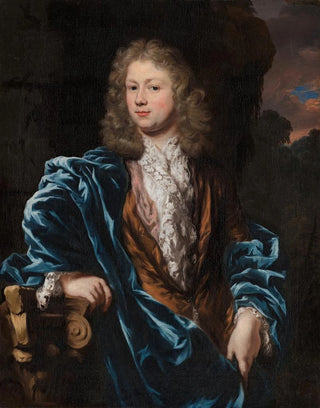Art print | Portrait of Cornelis ten Hove - Nicolaes Maes


View from behind

Frame (optional)
Portrait of Cornelis ten Hove - Nicolaes Maes – Captivating Introduction
The "Portrait of Cornelis ten Hove" by Nicolaes Maes is an iconic work that embodies the very essence of Dutch baroque portraiture. This painting, depicting a man of remarkable presence, invites us to delve into the fascinating world of the 17th century, where art and daily life intertwine with elegance. Maes's technical mastery, combined with his keen sense of character psychology, brings this portrait to life, transforming a simple face into an open window to the soul of his subject. Through this art print, we have the opportunity to rediscover the subtleties of human expression while admiring the craftsmanship of an artist whose fame marked his era.
Style and uniqueness of the work
Nicolaes Maes's style is distinguished by his ability to capture not only physical appearance but also the very essence of his subjects. In this portrait, the meticulous details of the clothing, the texture of the fabrics, and the light caressing Cornelis ten Hove's face testify to thorough observation. Maes uses a rich and harmonious color palette, creating a striking contrast between shadows and highlights. This play of light, characteristic of the baroque, accentuates facial features and adds emotional depth to the work. Ten Hove's serene and confident expression, along with his penetrating gaze, engage us and invite us to reflect on his personality and social status. This ability to evoke an intimate connection between the viewer and the subject is one of Maes's signatures, making each art print unique and memorable.
The artist and his influence
Nicolaes Maes, born in Dordrecht in 1634, is one of the major representatives of the Dutch painting school. A pupil of Rembrandt, he mastered his master's techniques while developing a style that is uniquely his own. Maes navigated between genre painting and portraiture, allowing him to explore various facets of the human condition. His influence on his contemporaries and future generations is undeniable. His approach to portraiture, combining realism and psychology, has

Matte finish

View from behind

Frame (optional)
Portrait of Cornelis ten Hove - Nicolaes Maes – Captivating Introduction
The "Portrait of Cornelis ten Hove" by Nicolaes Maes is an iconic work that embodies the very essence of Dutch baroque portraiture. This painting, depicting a man of remarkable presence, invites us to delve into the fascinating world of the 17th century, where art and daily life intertwine with elegance. Maes's technical mastery, combined with his keen sense of character psychology, brings this portrait to life, transforming a simple face into an open window to the soul of his subject. Through this art print, we have the opportunity to rediscover the subtleties of human expression while admiring the craftsmanship of an artist whose fame marked his era.
Style and uniqueness of the work
Nicolaes Maes's style is distinguished by his ability to capture not only physical appearance but also the very essence of his subjects. In this portrait, the meticulous details of the clothing, the texture of the fabrics, and the light caressing Cornelis ten Hove's face testify to thorough observation. Maes uses a rich and harmonious color palette, creating a striking contrast between shadows and highlights. This play of light, characteristic of the baroque, accentuates facial features and adds emotional depth to the work. Ten Hove's serene and confident expression, along with his penetrating gaze, engage us and invite us to reflect on his personality and social status. This ability to evoke an intimate connection between the viewer and the subject is one of Maes's signatures, making each art print unique and memorable.
The artist and his influence
Nicolaes Maes, born in Dordrecht in 1634, is one of the major representatives of the Dutch painting school. A pupil of Rembrandt, he mastered his master's techniques while developing a style that is uniquely his own. Maes navigated between genre painting and portraiture, allowing him to explore various facets of the human condition. His influence on his contemporaries and future generations is undeniable. His approach to portraiture, combining realism and psychology, has






